93 Search Results for mini schedule
May 14, 2018
by Carole Zangari -
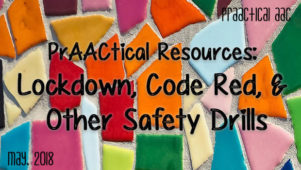
Recent events, such as the horrific mass shooting at Stoneman Douglas High School, have led us all to re-examine policies and procedures that impact school safety. Throughout the country, school communities are re-evaluating and fine-tuning their processes for keeping students and staff safe in the unlikely event of violent acts, such as bomb threats and active shooters. It seems surreal that we have to think about and plan for this, but that is our reality. We look at school safety drills for Code Red and lockdowns with a greater degree of importance and a heightened level of urgency. Our students with AAC needs are among the most vulnerable in any emergency situation and this is no different. Our students may have difficulty understanding what is happening in a drill or its implications. They may have difficulty moving quickly to get to a safe space or staying quiet once they get there.... [Read More...]
October 19, 2017
by Carole Zangari -
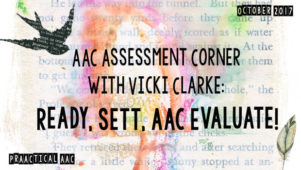
She’s bAACk! We couldn’t be happier to have another guest post on AAC assessment practices from Vicki Clarke of Dynamic Therapy Associates. In today’s post, she shares her tips and experiences for applying the SETT Framework to AAC assessment. If you are looking for information about how AACtual SLPs conduct their evaluations, Vicki’s posts are just what you need. You can view her previous contributions to the AAC Assessment Corner here. :::::::::::::::::::::::::::::::::::::::::::::::::::::::::::::::::::::::::::::::::::: Ready, SETT, AAC Evaluate! Last week I had the pleasure of joining the AAC After Work online conference hosted by Yapp Guru University. Jenna Coyer and I presented a session chatting about AAC assessment in emergent communicators. As we have worked to define our process for evaluation, we found ourselves repeatedly returning to the same approach our Assistive Technology teams use—the SETT Framework. The SETT Framework was developed by Joy Zabala as a process for making decisions about... [Read More...]
October 5, 2017
by Carole Zangari -
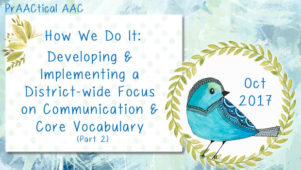
We’re back with Georgia-based SLP Jennifer Ro to hear more about a district-wide rollout of AAC in which they established (and have maintained) a core vocabulary focus. Jennifer is currently the lead AAC-SLP on Forsyth County Schools’ Assistive Technology Team where she provides AAC implementation support and trainings for staff and families and conducts individual AAC student consults. You can see Part 1 of the post here. Today, Jennifer shares some of what they learned in the process of creating AAC materials for the classroom and supporting the implementation of those materials. Let’s continue with more ‘lessons learned’ from this AAC experience. ================= How We Do It: Developing, Implementing a District-wide Focus on Communication & Core Vocabulary (Part 2) How we did it. And keep doing it … 😉 Create and develop supplemental materials that can be utilized universally and then modified, if needed, for individual student or teacher... [Read More...]
May 18, 2017
by Carole Zangari -
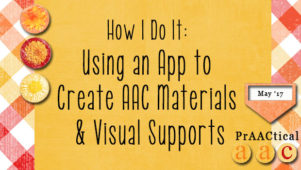
When we think of AAC apps, expressive communication and voice output generally come to mind. But there are other kinds of AAC apps, too, including those that are used to create printable materials. Today, we hear from a clinician who uses this kind of AAC app on a regular basis. Georgia Karavias is a speech language pathologist whose career has centered around working with school-aged children and adolescents who have physical disabilities and communication difficulties. Georgia is passionate about utilizing alternative access methods and inclusive technologies to enable independent communication using AAC systems. She currently works at Scope’s Communication and Inclusion Resource Centre (CIRC) as part of the communication access team in a community capacity building role. In this post, she talks about how she uses AAC and visual supports created with an app developed at her workplace. :::::::::::::::::::::::::::::::::::::::::::::::::::::::::::::::::::::::::::::::::::::::::::::::::::::::: I am a speech pathologist who has worked with children with complex... [Read More...]
December 5, 2016
by Carole Zangari -
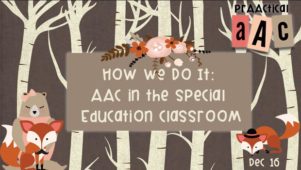
At the ASHA Convention last month, I chatted with an SLP about her secret longing: To take a sabbatical and travel the world to see AAC in action. Wouldn’t that be exciting?! In the meantime, we’ll have to live vicariously and peek into AAC practices through the words and pictures of dedicated professionals. Angi Pearce, a teacher at Kowhai Special School in Hastings, New Zealand, was kind enough to help us out and share her experiences in increasing AAC use in her classroom. Angi is the team leader for the Junior School classes (ages 5-11) and graciously prepared this post with support from SLP Michelle Roberts. As you’ll see, Angi is a highly experienced educator but new to the world of AAC and not afraid to take risks and embrace change. Let’s take a look at how a veteran teacher stretched herself to incorporate more AAC into her classroom. :::::::::::::::::::::::::::::::::::::::::::::::::::::::::::::::::::: AAC IN THE CLASSROOM My... [Read More...]
June 1, 2016
by Carole Zangari -

Today, we welcome back Vicki Clarke with more helpful information on conducting AAC assessments. If you work with individual who are at the early stages of communicative development, this post is for you! :::::::::::::::::::::::::::::::::::::::::::::::::::::::::: Some of my most favorite students are those who, at first, may not seem to notice me at all. Sometimes these students seem to exist in their own worlds. They don’t seem to respond in ways we would expect: looking, attending, listening, or gesturing. They may have a diagnosis of Autism, significant developmental delay, epilepsy, or any number of syndromes. I love these kids, and unfortunately, these are often the students who don’t get referred to me. Sometimes it takes years of working in a district before I get to see students with significant developmental delays. These children are typically served in classrooms for students considered to be severe/profound or multi-handicapped. Honestly, I usually get the... [Read More...]
October 27, 2015
by Carole Zangari -

As far as I can tell, most AAC learners are taught by people who don’t specialize in AAC. Their school SLPs may have caseloads of 50, 60, 70, or more students with IEPs, 90% of whom have goals for articulation, language, and fluency. Their classroom teachers serve students whose disabilities range from none at all, to dyslexia to cerebral palsy, to significant intellectual disabilities, and everywhere in between. In all likelihood, neither group had much AAC training. What little AAC they know, they’ve picked up on their own from reading, going to workshops and conferences (usually self-funded), talking to colleagues, and exploring online resources. Many times, their first foray into AAC is with things like choice boards and visual supports, such as daily schedules and first/then boards. From there, they may begin labeling the environment with pictures symbols (e.g., ‘table’ on the table, ‘on/off’ near the light switch), using mini-schedules... [Read More...]
October 19, 2015
by Carole Zangari -
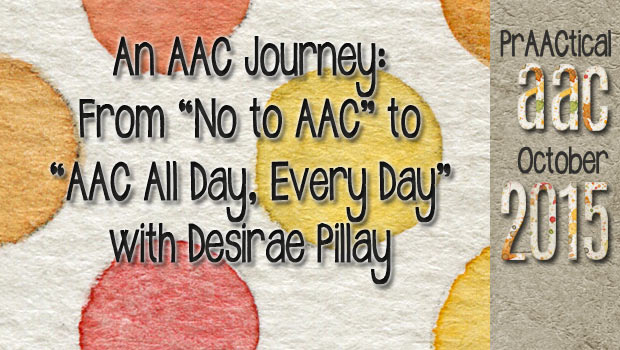
What better way to celebrate AAC Awareness Month than to share AAC stories from around the world? In this post, we welcome Desirae Pillay, who shares a bit about her daughter, Savannah, and their AAC journey. As the mother of a young adult with ASD and cerebral palsy, Desirae has taken what she has learned about AAC and is using it to help others outside of her family. Desirae began her journey with AAC in 2003 when she could not find a qualified AAC specialist to assist her with her daughter. Her experience and informal learning gained her a job for an AT company. When her daughter’s health needs became pressing, she resigned her job and worked part time as a Disability Consultant for various organisations. Desirae recently returned to work as an AT Advisor, where she trains on a range of topics about communication for people with disabilities. Her passion is for... [Read More...]
October 15, 2015
by Carole Zangari -
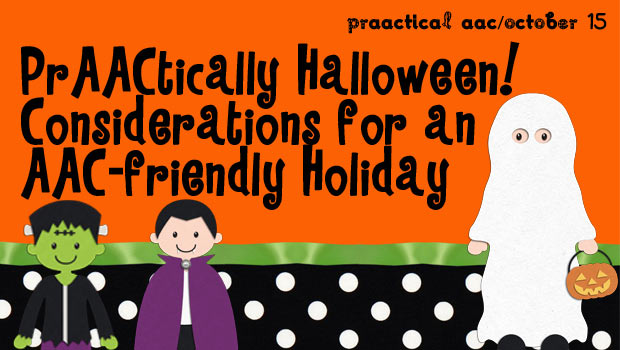
Holidays are special and Halloween is a favorite among many. As much fun as it is to dress up and get candy, though, there are lots of ways that Halloween can be stressful for AAC learners. From the change in routine, to the costumes and scary decorations, to talking with neighbors and other less familiar communication partners, to the over-abundance of sugar, there are lots of ways in which Halloween can trip us up. If the AAC learners in your life celebrate Halloween, Fall Festival, Harvest Parade, or any other celebration with similar traditions, we SLPs can help them to have a positive experience. Here are some ideas. Use a social narrative to prepare everyone for what to expect on and around Halloween. Read them often in the weeks leading up to the school dress-up parade, party, and the big day itself. More Halloween social narratives can be found at Therapics,... [Read More...]
October 5, 2015
by Carole Zangari -
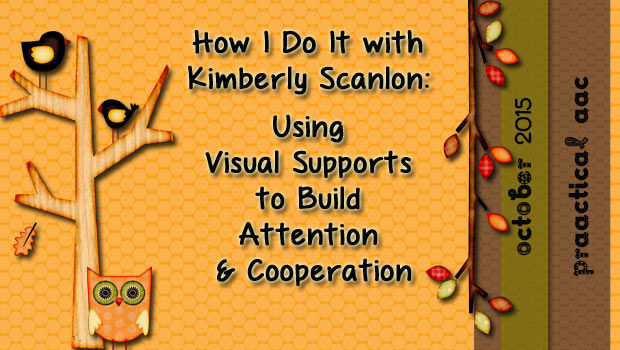
Having solid goals and fun activities is one thing, but being able to connect the two and teach communication and language takes skill. We have the best outcomes when the interventionist knows a variety of strategies that can support the learning outcomes. We’ve written about implementing countdown boards and other visual supports to build attention in the past, and have been gratified to hear from many of you who utilize those strategies. In today’s post, SLP Kimberly Scanlon, owner of Scanlon Speech Therapy, discusses how she implements this strategy and shares her own clever variation. You can download it at the end of the post. :::::::::::::::::::::::::::::::::::::::::::::::::::::::::::::::::: You plan the session. In fact, you over-plan and over prepare. You carefully select materials ensuring they are appropriate, engaging, and motivating for the client. Each activity will be short. Short is key as this student grows restless and losses interest rather quickly. You remove... [Read More...]









